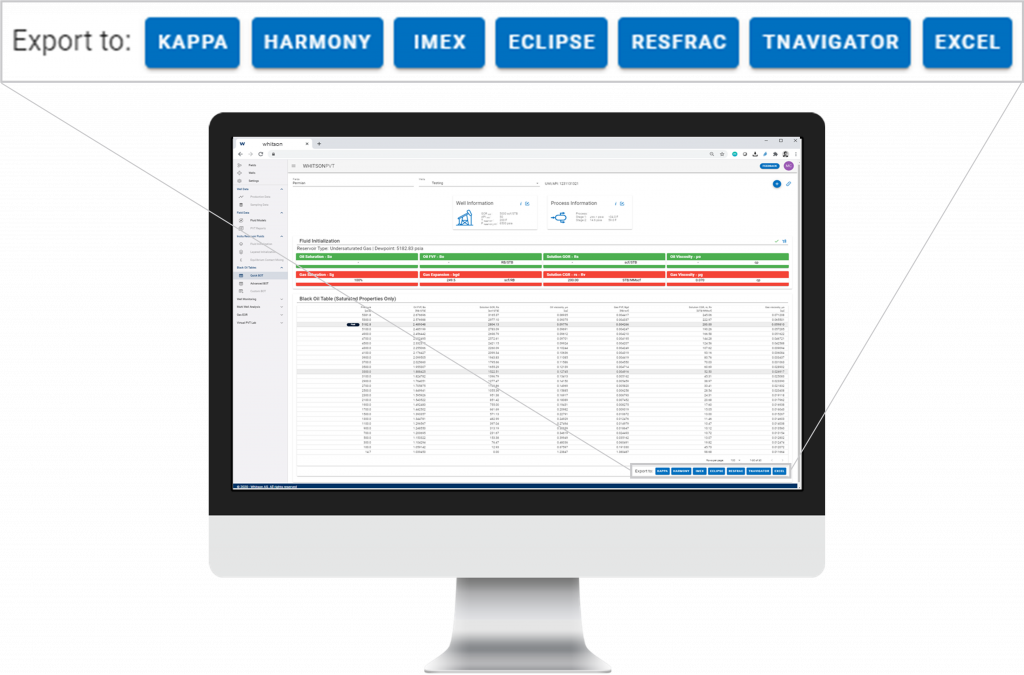Author: Mathias Carlsen

Most reservoir engineering analysis in the petroleum industry is performed utilizing black oil tables. In general, there are three different types of black oil tables: (1) traditional, (2) modified and (3) extrapolated. These are visually presented in the figure above and becomes more “sophisticated” as we move from left to right.
Traditional black oil tables (Bo, Rs, μo | bgw, μg) assume that all gas produced from the reservoir is “dry”, which is a decent assumption for fluid systems with an in-situ solution GOR (Rsi) less than 1000 scf/STB. Modifiedblack oil tables (Bo, Rs, μo | bgd, rs, μo) on the other hand, account for the condensate (oil) that is in solution with the reservoir gas. This becomes especially important for volatile oils, near critical fluids and gas condensates. Extrapolated black oil tables include extrapolation of saturated PVT properties to pressures higher than the maximum saturation pressure found initially in the reservoir. Important to note is that the volumetric black oil properties (Bo, Rs | bgd, rs) are dependent on the surface process (#stages, psep, Tsep).
In general, a black oil table is a two-component (oil and gas) PVT model, where three properties are defined for each component:
- Composition (Rs | rs) – surface process dependent
- Formation volume factor (Bo | Bgd) – surface process dependent
- Viscosity (μo | μg) – surface process independent
As emphasized by Fevang, Singh & Whitson (2000), modified black oil tables are in general adequate to model depletion processes as long as they are generated properly from an EOS model. For gas injection studies, however, a compositional simulation model is generally recommended, as further emphasized for unconventional reservoirs by Mydland & Whitson et al (2020).
The last few months we have been fortunate to work together with ResFrac Corporation (https://www.resfrac.com/) on a few items related to advanced black oil PVT in their simulation suite. ResFrac has gained substantial momentum among E&P companies in North-America the last few years with their fully integrated hydraulic fracturing and reservoir simulator. Their simulator has the capacity to model the full well life cycle from well treatment through production. We had the pleasure of working with their CEO, Dr. Mark McClure, and the rest of the ResFrac team, for a common client that wanted us to use one of our fluid models in the ResFrac software suite. The technically fruitful dialog with Dr. McClure and the rest of his team lead to three mutually beneficial implementations in both ResFrac and whitson’s software products.
- ResFrac now supports modeling of gas condensate reservoirs with modified black oil tables. These modified black oil tables contain both saturated and undersaturated PVT properties.
- whitsonPVT (whitson’s flagship software product) can now export ResFrac black oil table formats by a click of a button, as exemplified in Figure 2
- ResFrac are now implementing a button to streamline the import of this black oil table through their user-interface

The technical implementation speed on ResFrac’s side was truly impressive and has set the standard for quick iterations and execution. The interaction with the ResFrac team has been truly enjoyable and we are looking forward to more technical discussions in the future.
ResFrac has written a more comprehensive overview of their implementations here: https://www.resfrac.com/blog/collaborating-whitson-improve-resfracs-fluid-modeling
References:
Fevang, Ø., Singh, K., & Whitson, C. H. (2000, January 1). Guidelines for Choosing Compositional and Black-Oil Models for Volatile Oil and Gas-Condensate Reservoirs. Society of Petroleum Engineers. doi:10.2118/63087-MS
Mydland, S., Whitson, C. H, Carlsen, M. L, Dahouk, M.M. & Yusra, I. (2020, July 20). Black-Oil and Compositional Reservoir Simulation of Gas-Based EOR in Tight Unconventionals. URTeC Austin, Texas, USA, 20-22 July 2020.
Learn more about our consulting capabilities
###
Global
Curtis Hays Whitson
curtishays@whitson.com
Asia-Pacific
Kameshwar Singh
singh@whitson.com
Middle East
Ahmad Alavian
alavian@whitson.com
Americas
Mathias Lia Carlsen
carlsen@whitson.com
About whitson
whitson supports energy companies, oil services companies, investors and government organizations with expertise and expansive analysis within PVT, gas condensate reservoirs and gas-based EOR. Our coverage ranges from R&D based industry studies to detailed due diligence, transaction or court case projects. We help our clients find the best possible answers to complex questions and assist them in the successful decision-making on technical challenges. We do this through a continuous, transparent dialog with our clients – before, during and after our engagement. The company was founded by Dr. Curtis Hays Whitson in 1988 and is a Norwegian corporation located in Trondheim, Norway, with local presence in USA, Middle East, India and Indonesia
